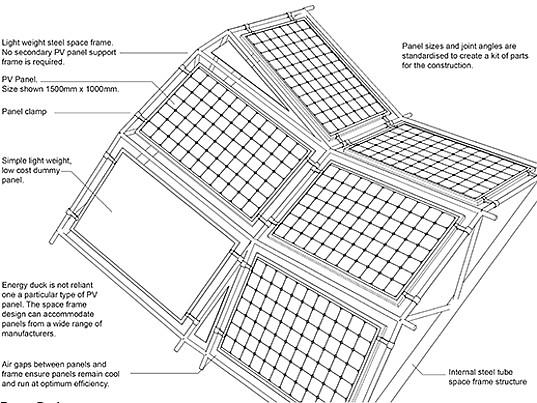385
Gigantic 'Energy Duck"
"Energy duck is an installation for a competition of alternative energy sources Land Art Generator Initiative (LAGI) 2014, which this year will be held in Copenhagen (Denmark). The project London team, composed of Gareth Pochi, Adam Khan, Louis Leger and Patrick fryer. Unusual and iconic structure will serve two purposes: it will act as a generator of renewable energy and to remind people that wildlife is in danger.

The "Energy duck" made in the likeness of the common eider duck, which inhabits the waters of Copenhagen. Unfortunately, the gag population is currently under threat due to the effects of climate change. Therefore, the team decided to use this form of structure, to raise global awareness about local environmental issues.

An unusual structure with a height of 12-storey building, expected to swim in the waters of the harbour. Frame will serve as a light steel frame which is then covered with lightweight steel cladding with integrated photovoltaic panels.

Solar radiation is converted into electricity using cheap solar panels. Further, some of the energy goes to urban needs, and part of the energy is stored using the difference in water level inside and outside of duck. At night when no solar radiation, a duck is filled with water under pressure, which is then passed through a hydraulic turbine, installed in it — this way produced electricity.

For visitors within the "Energy duck" steel frames will be installed on the Playground. From it it will be possible to admire the scenery of Copenhagen, as well as to see the process of filling reservoirs of a duck with water.

As stated by the team of creators of the installation: "it Often happens that the negative environmental effects of climate change caused by excessive emissions of carbon dioxide, may seem very distant issue. "Energy duck" highlights the issue of climate change, as well as the importance of renewable energy."

Source: www.ecobyt.ru/

The "Energy duck" made in the likeness of the common eider duck, which inhabits the waters of Copenhagen. Unfortunately, the gag population is currently under threat due to the effects of climate change. Therefore, the team decided to use this form of structure, to raise global awareness about local environmental issues.

An unusual structure with a height of 12-storey building, expected to swim in the waters of the harbour. Frame will serve as a light steel frame which is then covered with lightweight steel cladding with integrated photovoltaic panels.

Solar radiation is converted into electricity using cheap solar panels. Further, some of the energy goes to urban needs, and part of the energy is stored using the difference in water level inside and outside of duck. At night when no solar radiation, a duck is filled with water under pressure, which is then passed through a hydraulic turbine, installed in it — this way produced electricity.

For visitors within the "Energy duck" steel frames will be installed on the Playground. From it it will be possible to admire the scenery of Copenhagen, as well as to see the process of filling reservoirs of a duck with water.

As stated by the team of creators of the installation: "it Often happens that the negative environmental effects of climate change caused by excessive emissions of carbon dioxide, may seem very distant issue. "Energy duck" highlights the issue of climate change, as well as the importance of renewable energy."

Source: www.ecobyt.ru/






















